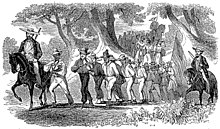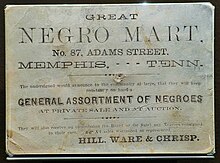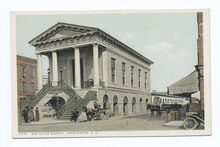

Slave markets and slave jails in the United States were places used for the slave trade in the United States from the founding in 1776 until the total abolition of slavery in 1865. Slave pens, also known as slave jails, were used to temporarily hold enslaved people until they were sold, or to hold fugitive slaves, and sometimes even to "board" slaves while traveling. Slave markets were any place where sellers and buyers gathered to make deals. Some of these buildings had dedicated slave jails, others were negro marts to showcase the slaves offered for sale, and still others were general auction or market houses where a wide variety of business was conducted, of which "negro trading" was just one part.
Slave trading was often done in business clusters where many trading firms operated in close proximity. Such clusters existed on specific streets (such as Pratt Street in Baltimore, Adams Street in Memphis, or Cherry Street in Nashville), in specific neighborhoods (in the American Quarter in New Orleans, and at Shockoe Bottom in Richmond), or in settlements seemingly dedicated to serving planters seeking new agricultural laborers (such as Forks of the Road market in Natchez, Mississippi, and at Hamburg, S.C., across the river from Augusta, Georgia). Many thousands of other sales took place on the steps of county courthouses (to satisfy judgments, estates and claims), on large plantations, or anywhere else there was a slave owner who needed cash in order to settle a debt or pay off a bad bet.

A slave market could operate without a dedicated jail, and a jail could operate without an associated market. For example, the grand hotels of New Orleans, and the Artesian Basin in Montgomery, Alabama, were important slave markets not known for their prison facilities. A number of slave jails in the Upper South were used for holding people until slave traders had enough for a shipment south, but were only rarely the site of slave sales, in part because the profit for the trader was sure to be higher in the Deep South, closer to the labor-hungry plantations of the cotton and sugar districts.
History
Dedicated marts, depots, and lockups were by no means ubiquitous, but the slave trade itself was: "The slave trade took place in nearly every town and city in the South. In most, however, the trade did not have a permanent physical location. Commonly, slaves were sold on court days, usually outdoors at a location near the courthouse, yet those cities with a large slave market had a significant infrastructure dedicated to the buying and selling of humans." [1] New Orleans was the great slave market of the lower Mississippi watershed—with hundreds of traders and a score of slave pens—but there were also markets and sales "at Donaldsonville, Clinton, and East Baton Rouge in Louisiana; at Natchez, Vicksburg, and Jackson in Mississippi; at every roadside tavern, county courthouse, and crossroads across the Lower South." [2] [3]

Slave traders traveled to farms and small towns to buy enslaved people to bring to market. [2] Slave owners also delivered people they wanted to dispense with. [4] Enslaved people were placed in pens to await being sold, and they could become quite crowded. [4] In New Orleans, most sales were made between September and May. Buyers visited the slave pen and inspected enslaved people prior to the sale. [5] People were held until their means of transportation was arranged. They were transported in groups by boat, walked to their new owners, or a combination of the two. They were moved in groups in a coffle. This meant that people were chained together with iron rings around their necks which were fastened with wooden or iron bars. Men on horseback herded the groups, or coffles, to their destination. They used dogs, guns, and whips. [4] Railroads brought a new, simpler means of travel that did not rely on the use of coffles. [4]
In some cases, slave traders, like Franklin and Armfield Office, had a network of slave depots that were located along their routes. [4] Circa 1833, an Appalachian newspaper complained about the slave traders traveling through the region with coffles, and reported that private jails had been built by slave traders at Baltimore, Washington, Norfolk, and near Fredericksburg. [6] According to Nile's Weekly Register of Baltimore in the 1840s, "The procurement of from fifty to three hundred slaves is a work of days, sometimes of weeks or months. Many plantations must be visited by the trader and his agents. Then a variety of circumstances occasions necessary delays, before the gang can be put in motion for the south. During this period the slaves are secured by handcuffs, fetters, and chains, and put into some place of confinement. The national prison at Washington city, and the state prisons, are prostituted to this use when occasion requires. The more extensive slave-dealers have private prisons constructed expressly for this purpose." [7]
Lumpkin's Jail, the largest in the state of Virginia, was a particularly inhumane place that resulted in people dying of starvation, illness, or beating. They were so cramped that they were sometimes on top of one another. There were no toilet facilities. [4] Swedish writer Fredrika Bremer described slave pens she saw on her travels in America as "great garrets without beds, chairs or tables." [8] Per Frederic Bancroft, "As a rule, in all such places, the floor was the only bed, a dirty blanket was the only covering, a miscellaneous bundle the only pillow. [8] A 1928 history described jail cells built on the Maryland farm of trader George Kephart: "...Mr. Kephart was probably the largest slavedealer in the county. He had two underground jails built where he kept the unruly, as well as a brick jail above ground." [9]




A negro mart was usually a type of urban retail market, usually consisting of a dedicated showroom and/or a workyard, a jail, and storerooms or kitchens for food. Negro marts were urban "clearinghouses" that both acquired enslaved people from more rural districts and sold people for use as farm, skilled, or domestic labor. The term negro mart was most commonly used in Charleston, South Carolina, but can also be found in Memphis, Tennessee, multiple locations in Georgia, et al. In the 1850s, future Confederate military leader Nathan Bedford Forrest operated a heavily advertised negro mart on Adams Street in Memphis. [11] In January 1860, the New York Times reported that the Forrest & Jones negro mart in Memphis had collapsed and caught fire; two people died but the bills of sale for people, "amounting in the aggregate to US$400,000 (equivalent to about $13,564,440 in 2023)" were salvaged. [12] A description of "the negro mart of Poindexter & Little" in New Orleans, Louisiana states: "In this mart the Negroes were classified and seated on benches, as goods are arranged on shelves in a well-regulated store. The cooks, mechanics, farm-hands, house-girls, seamstresses, washwomen, barbers, and boys each had their own place." [13] During the Civil War, Gideon J. Pillow wrote a complaint letter to the effect that U.S. Army troops had robbed him of his slaves, and killed or jailed his overseers; he wanted someone to check if the women and children, particularly, were "confined in the Ware house or Negro Mart." [14]
It was not uncommon to hold sales or auctions outdoors in the pre- air-conditioning South; the plaza north of the Charleston Exchange may be the most enduring and notable of these locations. Similarly, rather than depending on candles, kerosene, whale oil, or gaslights, the noon-to-three trading hours of the St. Louis Hotel in New Orleans probably took advantage of the brightest hours of natural light through the rotunda windows. Outdoor slave markets were sometimes controversial. Charleston banned outdoor sales in 1856 and the traders protested that the ban might subtly send a message that there was something wrong with buying and selling people. [15] And in 1837 a correspondent named D wrote to the New Orleans Times-Picayune complaining of being inconvenienced by the "practice which has been recently adopted by negro traders, I know not who, of parading their slaves for sale, on the narrow trottoir in front of the City Hotel, Common street...I have very frequently found much difficulty in making my way through the rank and file of men, women and children, there daily exhibited." [16]
After slavery

The Smithsonian magazine states that "[t]hese were sites of brutal treatment and unbearable sorrow, as callous and avaricious slave traders tore apart families, separating husbands from wives, and children from their parents." [17] During the Civil War, slave pens were used by the Union Army to imprison Confederate soldiers. For instance, slave pens were used for this purpose in St. Louis, Missouri and Alexandria, Virginia. [17] In Natchez, Mississippi, the Forks of the Road slave market was used by the Union soldiers to offer the formerly enslaved protection and freedom. [17] In 2021 the site was made part of the Natchez National Historical Park. [18]
Old slave pens were also repurposed for worship and education. In Lexington, Kentucky, Lewis Robards' slave jail was used as a Congregational church by African Americans. A freedmen's seminary, now Virginia Union University, was established in Lumpkin's Jail. Known as the "devil's half acre", a founder of the seminary James B. Simmons said that it would now be "God's half acre". [17] [4] A site formerly called A. Bryan's Negro Mart in Georgia, was commandeered by the U.S. military at the conclusion of the Civil War. It was later described as having four stars on the sign out front; the windows of the upper stories had iron grates, and among the abandoned detritus were "bills of sale for slaves by the hundreds," business correspondence, "handcuffs, whips, and staples for tying, etc." The building turned into a school for formerly enslaved children. [19]
Notable markets and jails


This is a list of notable buildings, structures, and landmarks (etc.), that were used in the slave trade in the United States. Different markets may well have been known for different "products". One historian wrote of New Orleans, "It was in the rotunda of the St. Louis Hotel that pulchritudinous slave girls, usually far removed in complexion from the sable hue of the typical slave women, were oftenest to be obtained. The auctioneers’ stands were solid blocks of masonry placed between the lofty columns which supported the domed roof. At one side of the rotunda were rooms where slaves might be confined temporarily, when necessary, or where men and women might be taken to undergo inspection by prospective purchasers more detailed than was possible in public. Hamilton, who was in the United States in 1843, and published a book about what he saw in New Orleans, adds a final touch: 'When a woman is sold, the auctioneer usually puts his audience in a good humor by a few indecent jokes...'" [20]: 150
- Artesian Basin (outdoor sales), Montgomery, Alabama
- Bar-room of the St. Charles Hotel, New Orleans [21]
- Brown's Speculator House (slave jail?), Montgomery, Ala. [22]
- Bruin's Slave Jail
- Cheapside Park, Lexington, Kentucky
- Charleston Exchange (outdoor sales, plaza north of building)
- Forks of the Road Market, Natchez, Mississippi
- Forrest's jail, Memphis
- Franklin and Armfield Office, Alexandria
- John Montmollin Warehouse, Savannah
- Lumpkin's Jail, Richmond
- Lynch's slave pen, St. Louis
- Mason County, Kentucky slave pen
- Nashville Market House
- Old Market (Louisville, Georgia)
- Old Slave Market, St. Augustine (disputed)
- Old Slave Mart, Charleston
- Poindexter & Little § Slave depot, New Orleans
- Slave Auction Block, Fredericksburg
- St. Louis Hotel, New Orleans
- The Cage, Richmond [23]
- Woodroof's jail, Lynchburg, Va.
- Woolfolk's jail, Baltimore
- The Yellow House, Washington, D.C. [24]
See also
- List of American slave traders
- List of African-American historic places
- Red flag (American slavery)
- Tavern trader
- Nineteenth-century American county courthouse architecture § County jails and sheriff's residences
- Torture of slaves in the United States
References
- ^ McInnis, Maurie D. (Fall 2013). "Mapping the slave trade in Richmond and New Orleans". Building & Landscapes. 20 (2): 102–125. doi: 10.5749/buildland.20.2.0102. JSTOR 10.5749/buildland.20.2.0102. S2CID 160472953.
- ^ a b Bancroft, Frederic (2023) [1931, 1996]. Slave Trading in the Old South (Original publisher: J. H. Fürst Co., Baltimore). Southern Classics Series. Introduction by Michael Tadman (Reprint ed.). Columbia, S.C.: University of South Carolina Press. ISBN 978-1-64336-427-8. LCCN 95020493. OCLC 1153619151.
- ^ Johnson, Walter (2013). River of Dark Dreams: Slavery and Empire in the Cotton Kingdom. Cambridge: Belknap Press of Harvard University Press. p. 86. ISBN 9780674074880. LCCN 2012030065. OCLC 827947225. OL 26179618M.
- ^ a b c d e f g Tucker, Abigail. "Digging up the Past at a Richmond Jail". Smithsonian Magazine. Retrieved 2021-05-06.
- ^ El-Shafei, Dahlia; Mason, Kate; O'Dwyer, Kathryn. "Henry Bibb and The Slave Pens of New Orleans - Stop 2 of 7 on the Urban Slavery and Everyday Resistance tour". New Orleans Historical. Retrieved 2021-05-06.
- ^ "A Most Disgraceful Business". Middlebury Register and Addison county Journal. 1833-01-22. p. 3. Retrieved 2023-09-18.
- ^ "Slavery and the internal slave trade in the United States of North America; being replies to questions transmitted by the Committee of the British and Foreign ..." HathiTrust. hdl: 2027/nyp.33433075911457. Retrieved 2023-09-11.
- ^ a b Bancroft, Frederic (2023) [1931]. Slave Trading in the Old South. Southern Classics Series. Introduction by Michael Tadman. University of South Carolina Press. pp. 322–323. ISBN 978-1-64336-427-8.
- ^ Grove, William Jarboe (1928). History of Carrollton manor, Frederick County, Maryland. Frederick, Md.: Marken & Bielfeld, Inc. hdl: 2027/mdp.39015024834841 – via HathiTrust.
- ^ Hurst, Jack (2011-06-08). Nathan Bedford Forrest: A Biography. Knopf Doubleday Publishing Group. pp. 56–58. ISBN 978-0-307-78914-3.
- ^ The Confederacy's Greatest Cavalryman: Nathan Bedford Forrest By Brian Steel Wills · 1998, University Press of Kansas, page 30
- ^ "A Double Catastrophe in Memphis. A NEGRO MARKET AND A NEWSPAPER OFFICE IN RUINS". The New York Times. 1860-01-19. ISSN 0362-4331. Retrieved 2023-05-04.
- ^ Alexander, Charles (1914). Battles and Victories of Allen Allensworth Lieutenant-Colonel, Retired, U.S. Army. Sherman, French. ISBN 978-0-598-48524-3.
- ^ Freedom: A Documentary History of Emancipation 1861-1867 Selected from the Holdings of the National Archivesof the United States. Cambridge University Press. 1985. p. 285. ISBN 978-0-521-13213-8.
- ^ Kytle, Ethan J.; Roberts, Blain (2018). Denmark Vesey's garden: slavery and memory in the cradle of the Confederacy. New York: The New Press. pp. 34–35. ISBN 9781620973660. LCCN 2017041546.
- ^ "Communicated". The Times-Picayune. 1837-02-22. p. 2. Retrieved 2023-12-11.
- ^ a b c d White, Jonathan W. "When Emancipation Finally Came, Slave Markets Took on a Redemptive Purpose". Smithsonian Magazine.
- ^ Mendoza, Brishette (July 3, 2021). "How a Slave Market Became a National Park Service Site". The New York Times. Archived from the original on July 3, 2021. Retrieved July 5, 2021.
- ^ Greatheed, Samuel; Parken, Daniel; Williams, Theophilus; Price, Thomas; Conder, Josiah; Ryland, Jonathan Edwards; Hood, Edwin Paxton (1865). The Eclectic Review.
- ^ Kendall, John S. (January 1939). "Shadow Over the City". The Louisiana Historical Quarterly. 22 (1). New Orleans: Louisiana Historical Society: 142–165. ISSN 0095-5949. OCLC 1782268. LDS Film 1425689, Image Group Number (DGS) 1640025 – via FamilySearch Digital Library.
- ^ "The American hotel; an anecdotal history". HathiTrust. p. 98. hdl: 2027/mdp.39015004273754. Retrieved 2023-11-07.
- ^ Calonius, Erik (2006). The Wanderer: the last American slave ship and the conspiracy that set its sails. New York, N.Y: Saint Martin's Press. p. 127. ISBN 978-0-312-34347-7.
- ^ Kambourian, Elizabeth Cann (2014-02-23). "Slave traders in Richmond (1819–1864)". Richmond Times-Dispatch. Virginia. pp. A12.
- ^ Magazine, Smithsonian. "The Notorious 'Yellow House' That Made Washington, D.C. a Slavery Capital". Smithsonian Magazine. Retrieved 2023-12-10.
Further reading
- Birch, Kelly (2017). Slavery and the origins of Louisiana's prison industry, 1803–1861 (Ph.D. thesis). Australia: University of Adelaide.
External links
- Cincinnati Magazine. Emmis Communications. July 2004. pp. 44–48.
- "E. S. Abdy description of a Washington, D.C., slave pen". Journal of a Residence and Tour in the United States of North America, From April, 1833, to October, 1834 – via PBS.
- "Presidents, Vice Presidents, and Washington's Most Notorious Slave Pen". White House Historical Association.
- A slave pen journey, National Underground Railroad Freedom Center, Cincinnati
- One-Time Slave Pen Now a Museum About the Horrors of Slavery One-Time Slave Pen Now a Museum About the Horrors of Slavery (VOA) on YouTube
- Antebellum architecture
- Defunct prisons in the United States
- Economic history of the United States
- Lists of buildings and structures in the United States
- Pre-emancipation African-American history
- Slavery in the United States
- Slave trade in the United States
- 19th-century architecture in the United States
- Commercial buildings in the United States